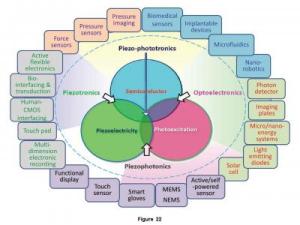Apr 15 2014
New technologies for developing electronics and optoelectronics with tunable/adaptive functionalities and performance are critical to emerging applications in wearable technology, communication, pervasive computing, human-machine interfacing and biomedical diagnostics, in which the active and adaptive interactions between devices and stimuli from the ambient/host (e. g. human body) are essential.
 This is a schematic diagram showing the prospects of utilizing piezotronic effect, which couples piezoelectric and semiconducting properties of piezoelectric semiconductor materials, for implementing many novel applications in tunable electronics, optoelectronics, spintronics, artificial photosynthesis and many other areas. Credit: ©Science China Press
This is a schematic diagram showing the prospects of utilizing piezotronic effect, which couples piezoelectric and semiconducting properties of piezoelectric semiconductor materials, for implementing many novel applications in tunable electronics, optoelectronics, spintronics, artificial photosynthesis and many other areas. Credit: ©Science China Press
Mechanical stimuli are ubiquitous and abundant in the environment for interacting with or controlling these electronics/optoelectronics. This is, however, not facile to implement using the state-of-the-art technology using semiconductor materials such as silicon, which rely on electrically-gated modulation of charge carriers by externally-applied voltage to perform intelligence-bearing operations.
Piezoelectric effect has been widely utilized for electromechanical sensing, actuating and energy harvesting, which produces polarization charges in response to mechanical deformation in materials lacking inversion symmetry. Conventional piezoelectric materials such as Pb(ZrxTi1-x)O3 (PZT) and polyvinylidene fluoride (PVDF) are insulators and hence not feasible for constructing functional electronics/optoelectronics. The effect of mechanically-induced polarization on charge carriers in piezoelectric materials has consequently been long overlooked. Semiconductor materials such as ZnO, GaN and CdS also possess piezoelectric properties but are not as extensively utilized in piezoelectric sensors and actuators due to their relatively small piezoelectric coefficients. The coupling of piezoelectric polarization with semiconductor properties in these materials has resulted in both novel fundamental phenomenon and unprecedented device applications, leading to the increasing research interests in the emerging field of piezotronics since its first discovery in 2006. Piezotronic effect is the modulation of charge carrier transport across metal-semiconductor (M-S) barrier or p-n junction by mechanical deformation, which results from the redistribution of free carriers and modification of band structure near the interface due to the existence of strain-induced polarization charges. Strain-induced polarization charges can hence effectively modulate the local interfacial band structure and charge carrier transport. Electronic devices fabricated by utilizing these interfacial piezoelectric polarization charges as "gate" controlling signal is piezotronics, which is fundamentally different from electrically-gated field effect transistor (FET). By replacing the external gating voltage with strain-induced polarization charges for controlling the charge transport, two-terminal strain-gated piezotronic transistors have been presented. More complex functionalities have also been developed following these preliminary demonstrations, such as strain-gated piezotronic logic nanodevices for performing mechanical action modulated electronic logic operation and piezotronic strain memory devices with write/read access of the memory cell programmed via electromechanical modulation for electrically recording and reading out the logical levels of applied strain. The sensitivity of Schottky-contact based sensors for detecting chemicals and biomolecules can also be significantly enhanced by piezoelectric polarization via the piezotronic effect. By replacing the traditional gate voltage with self-induced piezoelectric polarization in semiconductor nanomaterials, piezotronic nanodevices present a much simpler design with superior performance compared to conventional devices, which may offer new strategy for 3D structuring. Using the piezoelectric polarization charges created at M-S interface to modulate transport process of local charge carriers, piezotronic effect has be applied to design independently addressable two-terminal transistor arrays, which convert mechanical stimuli applied on the devices into local electronic controlling signals. Based on this concept, large-scale 3D integration of vertical ZnO nanowire (NW) transistors circuitry (92 × 92 tactile pixels in 1 cm2) as flexible force/pressure-sensor matrix for artificial skin has been designed and developed, which exhibits performance comparable to human skins and superior to any nanodevices previously demonstrated for tactile sensing, in terms of integration complexity, spatial resolution and response.
The piezoelectric polarization charges can also effectively modulate the optoelectronic processes, such as the generation, separation, diffusion and recombination, of charge carriers, which is the piezo-phototronic effect. This effect has been used to enhance the performance of photocells, the sensitivity of photodetectors and the external efficiency of an LED. Furthermore, it has recently demonstrated that strain-controlled LED emission can be used to directly 'image' the force/pressure distribution on the device with micrometer-resolution, based on the tuning of local light-emitting intensity from individual NW-LEDs by strain-induced polarization charges. The two-dimensional distribution of light-emission intensity then becomes a map of the pressure distribution on the surface. This approach is scientifically new because it relies on the piezoelectric polarization charges for designing a stable, fast response and parallel-detection strain-sensor arrays. The output signal is electroluminescence light, which is easy to integrate with photonic technologies for fast data transmission, processing and recording, and may enable the development of highly intelligent human-machine interfaces. This may represent a major step towards on-chip recording of mechanical signals by optical means.
The essence of the emerging research and applications in piezotronics and piezo-phototronics relies on the coupling between strain-induced polarization and semiconductor properties in piezoelectric semiconductor materials. These concepts provide the novel approach for modulating device characteristics by tuning the junction/contact properties, which has been unavailable in conventional technologies without modifying the interface structure or chemistry. It is prospected that piezotronics and piezo-phototronics will enable technology advances in sensing, human-electronics interfacing, robotics, biomedical therapy, prosthetics, bio-imaging and optical MEMS.